5. Neural Machine Translation - No Sampling¶
Vectorizing the source English and target French sentences requires a more complex pipeline than we have seen in pervious labs. There are two reasons for the increase in complexity.
First, the source and target sequences have different roles in the model, belong to different languages, and are vectorized in two different ways. Therefore,
the NMTVectorizer is instantiated with two separate
SequenceVocabularyobjects and two measurements of max sequence length, as shown in the constructor__init__function below.
Second, we use PyTorch’s
PackedSequencedata structure to handle variable length sequences in a more compact way than padded sequences. See a separate short notebook introducingPackedSequence. As a prerequisite to use PyTorch’sPackedSequences, we must sort each minibatch by the length of the source sentences.To address this complexity, the
generate_batches()function is modified to become thegenerate_nmt_batches()function, which produces a DataLoader that sort the minibatch into decending order of the sequence length, and then used in theNMTEncoderforward function.
Encoder and PackedSequence
The encoder in our model uses a bidirectional gated recurrent unit (biGRU) to compute vectors for each position in the source sequence that are informed by all parts of the sequence.
In general, the encoder takes as input a sequence of integers and creates a feature vector for each position. The output of the encoder in this example is these vectors and the final hidden state of the biGRU that is used to make the feature vectors. This hidden state is used to initialize the hidden state of the decoder.
Diving deeper into the encoder, we first embed the input sequence using an embedding layer. Usually, just by setting the padding_idx flag on the embedding layer, we enable the model to handle variablelength sequences because any position that equals padding_idx is given a zero-valued vector, which does not update during optimization. Recall that this is called the mask.
However, in this encoder–decoder model, masked positions need to be handled differently because we use a biGRU to encode the source sequence. The primary reason is that the backward component can be influenced by the masked positions, with a factor proportional to the number of masked positions it encounters before it starts on the sequence.
To handle the masked positions of variablelength sequences in the biGRU, we use PyTorch’s PackedSequence data structure. PackedSequences are derived from how CUDA allows for the
handling of variablelength sequences in a batched format. Any zero-padded sequence, such as the embedded source sequence in the encoder can be converted to a PackedSequence if two conditions are met:
the length of each sequence is provided, and
the minibatch is sorted according to the length of those sequences.
Decoder and Attentional Mechanism
The encoder maps each source sequence to a sequence of vector states with a biGRU and a final hidden state. The final hidden state is used as the decoder’s inital hidden state for a decoder, which uses attention mechanism to select different information in the source sequence to generate an output sequence.
5.1. Imports¶
import os
from argparse import Namespace
from collections import Counter
import json
import re
import string
import numpy as np
import pandas as pd
import torch
import torch.nn as nn
from torch.nn import functional as F
from torch.nn.utils.rnn import pack_padded_sequence, pad_packed_sequence
import torch.optim as optim
from torch.utils.data import Dataset, DataLoader
from tqdm.notebook import tqdm
5.2. From sentences to vectorised tokens (Vocabulary, Dataset, DataLoader, Vectorizer)¶
5.2.1. Vocabulary and SequenceVocabulary¶
These two classes are standard as we have seen earlier.
class Vocabulary(object):
"""Class to process text and extract vocabulary for mapping"""
def __init__(self, token_to_idx=None):
"""
Args:
token_to_idx (dict): a pre-existing map of tokens to indices
"""
if token_to_idx is None:
token_to_idx = {}
self._token_to_idx = token_to_idx
self._idx_to_token = {idx: token
for token, idx in self._token_to_idx.items()}
def to_serializable(self):
""" returns a dictionary that can be serialized """
return {'token_to_idx': self._token_to_idx}
@classmethod
def from_serializable(cls, contents):
""" instantiates the Vocabulary from a serialized dictionary """
return cls(**contents)
def add_token(self, token):
"""Update mapping dicts based on the token.
Args:
token (str): the item to add into the Vocabulary
Returns:
index (int): the integer corresponding to the token
"""
if token in self._token_to_idx:
index = self._token_to_idx[token]
else:
index = len(self._token_to_idx)
self._token_to_idx[token] = index
self._idx_to_token[index] = token
return index
def add_many(self, tokens):
"""Add a list of tokens into the Vocabulary
Args:
tokens (list): a list of string tokens
Returns:
indices (list): a list of indices corresponding to the tokens
"""
return [self.add_token(token) for token in tokens]
def lookup_token(self, token):
"""Retrieve the index associated with the token
Args:
token (str): the token to look up
Returns:
index (int): the index corresponding to the token
"""
return self._token_to_idx[token]
def lookup_index(self, index):
"""Return the token associated with the index
Args:
index (int): the index to look up
Returns:
token (str): the token corresponding to the index
Raises:
KeyError: if the index is not in the Vocabulary
"""
if index not in self._idx_to_token:
raise KeyError("the index (%d) is not in the Vocabulary" % index)
return self._idx_to_token[index]
def __str__(self):
return "<Vocabulary(size=%d)>" % len(self)
def __len__(self):
return len(self._token_to_idx)
class SequenceVocabulary(Vocabulary):
def __init__(self, token_to_idx=None, unk_token="<UNK>",
mask_token="<MASK>", begin_seq_token="<BEGIN>",
end_seq_token="<END>"):
super(SequenceVocabulary, self).__init__(token_to_idx)
self._mask_token = mask_token
self._unk_token = unk_token
self._begin_seq_token = begin_seq_token
self._end_seq_token = end_seq_token
self.mask_index = self.add_token(self._mask_token)
self.unk_index = self.add_token(self._unk_token)
self.begin_seq_index = self.add_token(self._begin_seq_token)
self.end_seq_index = self.add_token(self._end_seq_token)
def to_serializable(self):
contents = super(SequenceVocabulary, self).to_serializable()
contents.update({'unk_token': self._unk_token,
'mask_token': self._mask_token,
'begin_seq_token': self._begin_seq_token,
'end_seq_token': self._end_seq_token})
return contents
def lookup_token(self, token):
"""Retrieve the index associated with the token
or the UNK index if token isn't present.
Args:
token (str): the token to look up
Returns:
index (int): the index corresponding to the token
Notes:
`unk_index` needs to be >=0 (having been added into the Vocabulary)
for the UNK functionality
"""
if self.unk_index >= 0:
return self._token_to_idx.get(token, self.unk_index)
else:
return self._token_to_idx[token]
5.2.2. NMTVectorizer¶
Important
Vectorization of the source sequence
The source sequence is vectorized with the BEGINOFSEQUENCE token inserted at the beginning and the ENDOFSEQUENCE token added to the end. The model uses a biGRU to create summary vectors for each token in the source sentence, and these summary vectors greatly benefit from having an indication of sentence boundaries.
Important
Vectorization of the target sequence
The target sequence is vectorized as two copies offset by one token: the first copy needs the BEGINOFSEQUENCE token and the second
copy needs the ENDOFSEQUENCE token.
recall that sequence prediction tasks require observations of the input token and output token at every time step. The decoder in an seq2seq model is performing this task, but with the added availability of the encoder context. To address this complexity,
We make the core vectorization method,
_vectorize(), indifferent to whether it is the source or target indices.Then, two methods are written to handle the source and target indices separately.
Finally, these sets of indices are coordinated by using the
NMTVectorizer.vectorizemethod, which is the method invoked by the dataset.
class NMTVectorizer(object):
""" The Vectorizer which coordinates the Vocabularies and puts them to use"""
def __init__(self, source_vocab, target_vocab, max_source_length, max_target_length):
"""
Args:
source_vocab (SequenceVocabulary): maps source words to integers
target_vocab (SequenceVocabulary): maps target words to integers
max_source_length (int): the longest sequence in the source dataset
max_target_length (int): the longest sequence in the target dataset
"""
self.source_vocab = source_vocab
self.target_vocab = target_vocab
self.max_source_length = max_source_length
self.max_target_length = max_target_length
def _vectorize(self, indices, vector_length=-1, mask_index=0):
"""Vectorize the provided indices
Args:
indices (list): a list of integers that represent a sequence
vector_length (int): an argument for forcing the length of index vector
mask_index (int): the mask_index to use; almost always 0
"""
if vector_length < 0:
vector_length = len(indices)
vector = np.zeros(vector_length, dtype=np.int64)
vector[:len(indices)] = indices
vector[len(indices):] = mask_index
return vector
def _get_source_indices(self, text):
"""Return the vectorized source text
Args:
text (str): the source text; tokens should be separated by spaces
Returns:
indices (list): list of integers representing the text
"""
indices = [self.source_vocab.begin_seq_index]
indices.extend(self.source_vocab.lookup_token(token) for token in text.split(" "))
indices.append(self.source_vocab.end_seq_index)
return indices
def _get_target_indices(self, text):
"""Return the vectorized source text
Args:
text (str): the source text; tokens should be separated by spaces
Returns:
a tuple: (x_indices, y_indices)
x_indices (list): list of integers representing the observations in target decoder
y_indices (list): list of integers representing predictions in target decoder
"""
indices = [self.target_vocab.lookup_token(token) for token in text.split(" ")]
x_indices = [self.target_vocab.begin_seq_index] + indices
y_indices = indices + [self.target_vocab.end_seq_index]
return x_indices, y_indices
def vectorize(self, source_text, target_text, use_dataset_max_lengths=True):
"""Return the vectorized source and target text
The vetorized source text is just the a single vector.
The vectorized target text is split into two vectors in a similar style to
the surname modeling in Chapter 7.
At each timestep, the first vector is the observation and the second vector is the target.
Args:
source_text (str): text from the source language
target_text (str): text from the target language
use_dataset_max_lengths (bool): whether to use the global max vector lengths
Returns:
The vectorized data point as a dictionary with the keys:
source_vector, target_x_vector, target_y_vector, source_length
"""
source_vector_length = -1
target_vector_length = -1
if use_dataset_max_lengths:
source_vector_length = self.max_source_length + 2
target_vector_length = self.max_target_length + 1
source_indices = self._get_source_indices(source_text)
source_vector = self._vectorize(source_indices,
vector_length=source_vector_length,
mask_index=self.source_vocab.mask_index)
target_x_indices, target_y_indices = self._get_target_indices(target_text)
target_x_vector = self._vectorize(target_x_indices,
vector_length=target_vector_length,
mask_index=self.target_vocab.mask_index)
target_y_vector = self._vectorize(target_y_indices,
vector_length=target_vector_length,
mask_index=self.target_vocab.mask_index)
return {"source_vector": source_vector,
"target_x_vector": target_x_vector,
"target_y_vector": target_y_vector,
"source_length": len(source_indices)}
@classmethod
def from_dataframe(cls, bitext_df):
"""Instantiate the vectorizer from the dataset dataframe
Args:
bitext_df (pandas.DataFrame): the parallel text dataset
Returns:
an instance of the NMTVectorizer
"""
source_vocab = SequenceVocabulary()
target_vocab = SequenceVocabulary()
max_source_length = 0
max_target_length = 0
for _, row in bitext_df.iterrows():
source_tokens = row["source_language"].split(" ")
if len(source_tokens) > max_source_length:
max_source_length = len(source_tokens)
for token in source_tokens:
source_vocab.add_token(token)
target_tokens = row["target_language"].split(" ")
if len(target_tokens) > max_target_length:
max_target_length = len(target_tokens)
for token in target_tokens:
target_vocab.add_token(token)
return cls(source_vocab, target_vocab, max_source_length, max_target_length)
@classmethod
def from_serializable(cls, contents):
source_vocab = SequenceVocabulary.from_serializable(contents["source_vocab"])
target_vocab = SequenceVocabulary.from_serializable(contents["target_vocab"])
return cls(source_vocab=source_vocab,
target_vocab=target_vocab,
max_source_length=contents["max_source_length"],
max_target_length=contents["max_target_length"])
def to_serializable(self):
return {"source_vocab": self.source_vocab.to_serializable(),
"target_vocab": self.target_vocab.to_serializable(),
"max_source_length": self.max_source_length,
"max_target_length": self.max_target_length}
5.2.3. NMTDataset¶
class NMTDataset(Dataset):
def __init__(self, text_df, vectorizer):
"""
Args:
surname_df (pandas.DataFrame): the dataset
vectorizer (SurnameVectorizer): vectorizer instatiated from dataset
"""
self.text_df = text_df
self._vectorizer = vectorizer
self.train_df = self.text_df[self.text_df.split=='train']
self.train_size = len(self.train_df)
self.val_df = self.text_df[self.text_df.split=='val']
self.validation_size = len(self.val_df)
self.test_df = self.text_df[self.text_df.split=='test']
self.test_size = len(self.test_df)
self._lookup_dict = {'train': (self.train_df, self.train_size),
'val': (self.val_df, self.validation_size),
'test': (self.test_df, self.test_size)}
self.set_split('train')
@classmethod
def load_dataset_and_make_vectorizer(cls, dataset_csv):
"""Load dataset and make a new vectorizer from scratch
Args:
surname_csv (str): location of the dataset
Returns:
an instance of SurnameDataset
"""
text_df = pd.read_csv(dataset_csv)
train_subset = text_df[text_df.split=='train']
return cls(text_df, NMTVectorizer.from_dataframe(train_subset))
@classmethod
def load_dataset_and_load_vectorizer(cls, dataset_csv, vectorizer_filepath):
"""Load dataset and the corresponding vectorizer.
Used in the case in the vectorizer has been cached for re-use
Args:
surname_csv (str): location of the dataset
vectorizer_filepath (str): location of the saved vectorizer
Returns:
an instance of SurnameDataset
"""
text_df = pd.read_csv(dataset_csv)
vectorizer = cls.load_vectorizer_only(vectorizer_filepath)
return cls(text_df, vectorizer)
@staticmethod
def load_vectorizer_only(vectorizer_filepath):
"""a static method for loading the vectorizer from file
Args:
vectorizer_filepath (str): the location of the serialized vectorizer
Returns:
an instance of SurnameVectorizer
"""
with open(vectorizer_filepath) as fp:
return NMTVectorizer.from_serializable(json.load(fp))
def save_vectorizer(self, vectorizer_filepath):
"""saves the vectorizer to disk using json
Args:
vectorizer_filepath (str): the location to save the vectorizer
"""
with open(vectorizer_filepath, "w") as fp:
json.dump(self._vectorizer.to_serializable(), fp)
def get_vectorizer(self):
""" returns the vectorizer """
return self._vectorizer
def set_split(self, split="train"):
self._target_split = split
self._target_df, self._target_size = self._lookup_dict[split]
def __len__(self):
return self._target_size
def __getitem__(self, index):
"""the primary entry point method for PyTorch datasets
Args:
index (int): the index to the data point
Returns:
a dictionary holding the data point: (x_data, y_target, class_index)
"""
row = self._target_df.iloc[index]
vector_dict = self._vectorizer.vectorize(row.source_language, row.target_language)
return {"x_source": vector_dict["source_vector"],
"x_target": vector_dict["target_x_vector"],
"y_target": vector_dict["target_y_vector"],
"x_source_length": vector_dict["source_length"]}
def get_num_batches(self, batch_size):
"""Given a batch size, return the number of batches in the dataset
Args:
batch_size (int)
Returns:
number of batches in the dataset
"""
return len(self) // batch_size
5.2.4. DataLoader - Generate NMT Batches using PackedSequence¶
There are two prerequisites for creating a PackedSequence:
knowing the length of each sequence, and
sorting the sequences in descending order by the length of the source sequence.
To reflect this newly sorted matrix, the remaining tensors in the minibatch are sorted in the same order so that they stay aligned with the source sequence encoding. The actual packing and unpacking of PackedSequences happens in the forward() function of the NMTEncoder model .
def generate_nmt_batches(dataset, batch_size, shuffle=True,
drop_last=True, device="cpu"):
"""A generator function which wraps the PyTorch DataLoader. The NMT Version """
dataloader = DataLoader(dataset=dataset, batch_size=batch_size,
shuffle=shuffle, drop_last=drop_last)
for data_dict in dataloader:
lengths = data_dict['x_source_length'].numpy()
# Get the indices according to sorted length
sorted_length_indices = lengths.argsort()[::-1].tolist()
# Sort the minibatch
out_data_dict = {}
for name, tensor in data_dict.items():
out_data_dict[name] = data_dict[name][sorted_length_indices].to(device)
yield out_data_dict
5.3. Neural Machine Translation Model¶
Components:
NMTEncoder
accepts as input a source sequence to be embedded and fed through a bi-directional GRU
NMTDecoder
using the encoder state and attention, the decoder generates a new sequence
the ground truth target sequence is used as input to the decoder at each time step
an alternative formulation would allow some of the decoder’s own choices to be used as input
this is referred to as curriculum learning, learning to search
NMTModel
Combines the encoder and decoder into a single class.
5.3.1. NMTEncoder¶
In the forward() function, PyTorch’s pack_padded_sequence() function is evoked by passing the embedded sequences, the lengths of the sequences, and a Boolean flag indicating a batch-first tensor. The output of this function is a PackedSequence. The resulting
PackedSequence is input into the biGRU to create hidden state vectors for the downstream decoder.
The output of the biGRU is unpacked into a full tensor. The unpacking operation, sets each masked position to be a zero-valued vector, preserving the integrity for downstream computations.
class NMTEncoder(nn.Module):
def __init__(self, num_embeddings, embedding_size, rnn_hidden_size):
"""
Args:
num_embeddings (int): number of embeddings is the size of source vocabulary
embedding_size (int): size of the embedding vectors
rnn_hidden_size (int): size of the RNN hidden state vectors
"""
super(NMTEncoder, self).__init__()
self.source_embedding = nn.Embedding(num_embeddings, embedding_size, padding_idx=0)
self.birnn = nn.GRU(embedding_size, rnn_hidden_size, bidirectional=True, batch_first=True)
def forward(self, x_source, x_lengths):
"""The forward pass of the model
Args:
x_source (torch.Tensor): the input data tensor.
x_source.shape is (batch, seq_size)
x_lengths (torch.Tensor): a vector of lengths for each item in the batch
Returns:
a tuple: x_unpacked (torch.Tensor), x_birnn_h (torch.Tensor)
x_unpacked.shape = (batch, seq_size, rnn_hidden_size * 2)
x_birnn_h.shape = (batch, rnn_hidden_size * 2)
"""
x_embedded = self.source_embedding(x_source)
# create PackedSequence; x_packed.data.shape=(number_items, embeddign_size)
x_packed = pack_padded_sequence(x_embedded, x_lengths.detach().cpu().numpy(),
batch_first=True)
# x_birnn_h.shape = (num_rnn, batch_size, feature_size)
x_birnn_out, x_birnn_h = self.birnn(x_packed)
# permute to (batch_size, num_rnn, feature_size)
x_birnn_h = x_birnn_h.permute(1, 0, 2)
# flatten features; reshape to (batch_size, num_rnn * feature_size)
# (recall: -1 takes the remaining positions,
# flattening the two RNN hidden vectors into 1)
x_birnn_h = x_birnn_h.contiguous().view(x_birnn_h.size(0), -1)
x_unpacked, _ = pad_packed_sequence(x_birnn_out, batch_first=True)
return x_unpacked, x_birnn_h
5.3.2. Attention Mechanism¶
The attention mechanism can be described as the decoder uses queries, to match with keys in the encoder in order to work out the distribution of the values that contributes to the context vector. A score function takes as input the query vector and the key vectors to compute a set of weights that select among the value vectors.
In this example, we use the dot product scoring function, but it is not the only one. In this example, the decoder’s hidden state is used as the query vector, and the set of encoder state vectors are both the key and value vectors. The dot product of the decoder’s hidden state with the vectors in the encoder state creates a scalar for each item in the encoded sequence. Upon using the softmax function, these scalars become a probability distribution over the vectors in the encoder state. These probabilities are used to weight
the encoder state vectors before they are added together to result in a single vector (i.e. the context vector) for each batch item.
Note
To summarize, the decoder hidden state is allowed to preferentially weight the encoder state at each time step.
This is like a spotlight, giving the model the ability to learn how to highlight the information it needs to generate an output sequence. We demonstrate this version of the attention mechanism in verbose_attention(). This function tries to verbosely spell out the operations. Additionally, it uses the view() operation to insert dimensions with size 1 so that the tensor can be broadcast against another tensor.
In the terse_attention() version, the view() operation is replaced with the more
commonly accepted practice, unsqueeze(). In addition, rather than multiplying elementwise and summing, the more efficient matmul() operation is used.
Your Turn
Modify the code below to use torch.bmm().
def verbose_attention(encoder_state_vectors, query_vector):
"""A descriptive version of the neural attention mechanism
Args:
encoder_state_vectors (torch.Tensor): 3dim tensor from bi-GRU in encoder
query_vector (torch.Tensor): hidden state in decoder GRU
Returns:
"""
batch_size, num_vectors, vector_size = encoder_state_vectors.size()
vector_scores = torch.sum(encoder_state_vectors * query_vector.view(batch_size, 1, vector_size),
dim=2)
vector_probabilities = F.softmax(vector_scores, dim=1)
weighted_vectors = encoder_state_vectors * vector_probabilities.view(batch_size, num_vectors, 1)
context_vectors = torch.sum(weighted_vectors, dim=1)
return context_vectors, vector_probabilities, vector_scores
def terse_attention(encoder_state_vectors, query_vector):
"""A shorter and more optimized version of the neural attention mechanism
Args:
encoder_state_vectors (torch.Tensor): 3dim tensor from bi-GRU in encoder
query_vector (torch.Tensor): hidden state
"""
vector_scores = torch.matmul(encoder_state_vectors, query_vector.unsqueeze(dim=2)).squeeze()
vector_probabilities = F.softmax(vector_scores, dim=-1)
context_vectors = torch.matmul(encoder_state_vectors.transpose(-2, -1),
vector_probabilities.unsqueeze(dim=2)).squeeze()
return context_vectors, vector_probabilities
5.3.3. NMTDecoder¶
After the encoder creates the state vectors with its biGRU and packing-unpacking coordination, the decoder iterates over the time steps to generate an output sequence. Functionally, this loop should seem very similar to the generation loop we have seen before, but with a few differences that are distinctly the methodological choices of Luong, Pham, and Manning’s (2015) style of attention.
First, a target sequence is provided as observations at each time step.
Hidden states are computed by using a GRUCell.
The initial hidden state is computed by applying a Linear layer to the concatenated final hidden states of the encoder biGRU.
The input to the decoder GRU at each time step is a concatenated vector of an embedded input token and the last time step’s context vector.
The context vector is intended to capture information that is useful for that time step and acts to condition the output of the model.
For the first time step, the context vector is all 0s to represent no context and mathematically allow only the input to contribute to the GRU computation.
Using the new hidden state as a query vector, a new set of context vectors are created using the attention mechanism for the current time step.
These context vectors are concatenated with the hidden state to create a vector representing the decoding information at that time step.
This decoding information state vector is used in a classifier (in this case, a simple Linear layer) to create a prediction vector, score_for_y_t_index. These prediction vectors can be turned into probability distributions over the output vocabulary using the softmax function, or they can be used with cross-entropy loss to optimize for ground truth targets.
class NMTDecoder(nn.Module):
def __init__(self, num_embeddings, embedding_size, rnn_hidden_size, bos_index):
"""
Args:
num_embeddings (int): number of embeddings is also the number of
unique words in target vocabulary
embedding_size (int): the embedding vector size
rnn_hidden_size (int): size of the hidden rnn state
bos_index(int): begin-of-sequence index
"""
super(NMTDecoder, self).__init__()
self._rnn_hidden_size = rnn_hidden_size
self.target_embedding = nn.Embedding(num_embeddings=num_embeddings,
embedding_dim=embedding_size,
padding_idx=0)
self.gru_cell = nn.GRUCell(embedding_size + rnn_hidden_size,
rnn_hidden_size)
self.hidden_map = nn.Linear(rnn_hidden_size, rnn_hidden_size)
self.classifier = nn.Linear(rnn_hidden_size * 2, num_embeddings)
self.bos_index = bos_index
def _init_indices(self, batch_size):
""" return the BEGIN-OF-SEQUENCE index vector """
return torch.ones(batch_size, dtype=torch.int64) * self.bos_index
def _init_context_vectors(self, batch_size):
""" return a zeros vector for initializing the context """
return torch.zeros(batch_size, self._rnn_hidden_size)
def forward(self, encoder_state, initial_hidden_state, target_sequence):
"""The forward pass of the model
Args:
encoder_state (torch.Tensor): the output of the NMTEncoder
initial_hidden_state (torch.Tensor): The last hidden state in the NMTEncoder
target_sequence (torch.Tensor): the target text data tensor
Returns:
output_vectors (torch.Tensor): prediction vectors at each output step
"""
# We are making an assumption there: The batch is on first
# The input is (Batch, Seq)
# We want to iterate over sequence so we permute it to (S, B)
target_sequence = target_sequence.permute(1, 0)
output_sequence_size = target_sequence.size(0)
# use the provided encoder hidden state as the initial hidden state
h_t = self.hidden_map(initial_hidden_state)
batch_size = encoder_state.size(0)
# initialize context vectors to zeros
context_vectors = self._init_context_vectors(batch_size)
# initialize first y_t word as BOS
y_t_index = self._init_indices(batch_size)
h_t = h_t.to(encoder_state.device)
y_t_index = y_t_index.to(encoder_state.device)
context_vectors = context_vectors.to(encoder_state.device)
output_vectors = []
self._cached_p_attn = []
self._cached_ht = []
self._cached_decoder_state = encoder_state.cpu().detach().numpy()
for i in range(output_sequence_size):
y_t_index = target_sequence[i]
# Step 1: Embed word and concat with previous context
y_input_vector = self.target_embedding(y_t_index)
rnn_input = torch.cat([y_input_vector, context_vectors], dim=1)
# Step 2: Make a GRU step, getting a new hidden vector
h_t = self.gru_cell(rnn_input, h_t)
self._cached_ht.append(h_t.cpu().detach().numpy())
# Step 3: Use the current hidden to attend to the encoder state
context_vectors, p_attn, _ = verbose_attention(encoder_state_vectors=encoder_state,
query_vector=h_t)
# auxillary: cache the attention probabilities for visualization
self._cached_p_attn.append(p_attn.cpu().detach().numpy())
# Step 4: Use the current hidden and context vectors to make a prediction to the next word
prediction_vector = torch.cat((context_vectors, h_t), dim=1)
score_for_y_t_index = self.classifier(F.dropout(prediction_vector, 0.3))
# auxillary: collect the prediction scores
output_vectors.append(score_for_y_t_index)
output_vectors = torch.stack(output_vectors).permute(1, 0, 2)
return output_vectors
5.3.4. NMTModel¶
The model that connects NMTdecoder with NMTEncoder.
class NMTModel(nn.Module):
""" The Neural Machine Translation Model """
def __init__(self, source_vocab_size, source_embedding_size,
target_vocab_size, target_embedding_size, encoding_size,
target_bos_index):
"""
Args:
source_vocab_size (int): number of unique words in source language
source_embedding_size (int): size of the source embedding vectors
target_vocab_size (int): number of unique words in target language
target_embedding_size (int): size of the target embedding vectors
encoding_size (int): the size of the encoder RNN.
"""
super(NMTModel, self).__init__()
self.encoder = NMTEncoder(num_embeddings=source_vocab_size,
embedding_size=source_embedding_size,
rnn_hidden_size=encoding_size)
decoding_size = encoding_size * 2
self.decoder = NMTDecoder(num_embeddings=target_vocab_size,
embedding_size=target_embedding_size,
rnn_hidden_size=decoding_size,
bos_index=target_bos_index)
def forward(self, x_source, x_source_lengths, target_sequence):
"""The forward pass of the model
Args:
x_source (torch.Tensor): the source text data tensor.
x_source.shape should be (batch, vectorizer.max_source_length)
x_source_lengths torch.Tensor): the length of the sequences in x_source
target_sequence (torch.Tensor): the target text data tensor
Returns:
decoded_states (torch.Tensor): prediction vectors at each output step
"""
encoder_state, final_hidden_states = self.encoder(x_source, x_source_lengths)
decoded_states = self.decoder(encoder_state=encoder_state,
initial_hidden_state=final_hidden_states,
target_sequence=target_sequence)
return decoded_states
5.4. Training Routine and Bookkeeping Functions¶
The training routine for this example is nearly identical to the training routines seen previously.
However, each minibatch here is composed of four tensors:
a matrix of integers for the source sequence,
two matrices of integers for the target sequence, and
a vector of integers for the source sequence lengths.
The two target sequence matrices are
the target sequence offset by one and padded with either
BEGINOFSEQUENCEtokens to act as target sequence observations orENDOSEQUENCE tokens to act as target sequence prediction labels.
The model takes as input the source sequence and the target sequence observations to produce target sequence predictions. The target sequence prediction labels are used in the loss function to compute the crossentropy loss, which is then backpropagated to each model parameter so that it knows its gradient. The optimizer is then invoked and updates each model parameter by some amount proportional to the gradient.
def set_seed_everywhere(seed, cuda):
np.random.seed(seed)
torch.manual_seed(seed)
if cuda:
torch.cuda.manual_seed_all(seed)
def handle_dirs(dirpath):
if not os.path.exists(dirpath):
os.makedirs(dirpath)
def make_train_state(args):
return {'stop_early': False,
'early_stopping_step': 0,
'early_stopping_best_val': 1e8,
'learning_rate': args.learning_rate,
'epoch_index': 0,
'train_loss': [],
'train_acc': [],
'val_loss': [],
'val_acc': [],
'test_loss': -1,
'test_acc': -1,
'model_filename': args.model_state_file}
def update_train_state(args, model, train_state):
"""Handle the training state updates.
Components:
- Early Stopping: Prevent overfitting.
- Model Checkpoint: Model is saved if the model is better
:param args: main arguments
:param model: model to train
:param train_state: a dictionary representing the training state values
:returns:
a new train_state
"""
# Save one model at least
if train_state['epoch_index'] == 0:
torch.save(model.state_dict(), train_state['model_filename'])
train_state['stop_early'] = False
# Save model if performance improved
elif train_state['epoch_index'] >= 1:
loss_tm1, loss_t = train_state['val_loss'][-2:]
# If loss worsened
if loss_t >= loss_tm1:
# Update step
train_state['early_stopping_step'] += 1
# Loss decreased
else:
# Save the best model
if loss_t < train_state['early_stopping_best_val']:
torch.save(model.state_dict(), train_state['model_filename'])
train_state['early_stopping_best_val'] = loss_t
# Reset early stopping step
train_state['early_stopping_step'] = 0
# Stop early ?
train_state['stop_early'] = \
train_state['early_stopping_step'] >= args.early_stopping_criteria
return train_state
def normalize_sizes(y_pred, y_true):
"""Normalize tensor sizes
Args:
y_pred (torch.Tensor): the output of the model
If a 3-dimensional tensor, reshapes to a matrix
y_true (torch.Tensor): the target predictions
If a matrix, reshapes to be a vector
"""
if len(y_pred.size()) == 3:
y_pred = y_pred.contiguous().view(-1, y_pred.size(2))
if len(y_true.size()) == 2:
y_true = y_true.contiguous().view(-1)
return y_pred, y_true
def compute_accuracy(y_pred, y_true, mask_index):
y_pred, y_true = normalize_sizes(y_pred, y_true)
_, y_pred_indices = y_pred.max(dim=1)
correct_indices = torch.eq(y_pred_indices, y_true).float()
valid_indices = torch.ne(y_true, mask_index).float()
n_correct = (correct_indices * valid_indices).sum().item()
n_valid = valid_indices.sum().item()
return n_correct / n_valid * 100
def sequence_loss(y_pred, y_true, mask_index):
y_pred, y_true = normalize_sizes(y_pred, y_true)
return F.cross_entropy(y_pred, y_true, ignore_index=mask_index)
torch.cuda.is_available()
True
args = Namespace(dataset_csv="../data/nmt/simplest_eng_fra.csv",
vectorizer_file="vectorizer.json",
model_state_file="model.pth",
save_dir="model_storage/nmt_luong_no_sampling",
reload_from_files=True,
expand_filepaths_to_save_dir=True,
cuda=True,
seed=1337,
learning_rate=5e-4,
batch_size=64,
num_epochs=100,
early_stopping_criteria=5,
source_embedding_size=64,
target_embedding_size=64,
encoding_size=64,
catch_keyboard_interrupt=True)
if args.expand_filepaths_to_save_dir:
args.vectorizer_file = os.path.join(args.save_dir,
args.vectorizer_file)
args.model_state_file = os.path.join(args.save_dir,
args.model_state_file)
print("Expanded filepaths: ")
print("\t{}".format(args.vectorizer_file))
print("\t{}".format(args.model_state_file))
# Check CUDA
if not torch.cuda.is_available():
args.cuda = False
args.device = torch.device("cuda" if args.cuda else "cpu")
print("Using CUDA: {}".format(args.cuda))
# Set seed for reproducibility
set_seed_everywhere(args.seed, args.cuda)
# handle dirs
handle_dirs(args.save_dir)
Expanded filepaths:
model_storage/nmt_luong_no_sampling\vectorizer.json
model_storage/nmt_luong_no_sampling\model.pth
Using CUDA: True
if args.reload_from_files and os.path.exists(args.vectorizer_file):
# training from a checkpoint
dataset = NMTDataset.load_dataset_and_load_vectorizer(args.dataset_csv,
args.vectorizer_file)
else:
# create dataset and vectorizer
dataset = NMTDataset.load_dataset_and_make_vectorizer(args.dataset_csv)
dataset.save_vectorizer(args.vectorizer_file)
vectorizer = dataset.get_vectorizer()
model = NMTModel(source_vocab_size=len(vectorizer.source_vocab),
source_embedding_size=args.source_embedding_size,
target_vocab_size=len(vectorizer.target_vocab),
target_embedding_size=args.target_embedding_size,
encoding_size=args.encoding_size,
target_bos_index=vectorizer.target_vocab.begin_seq_index)
if args.reload_from_files and os.path.exists(args.model_state_file):
model.load_state_dict(torch.load(args.model_state_file))
print("Reloaded model")
else:
print("New model")
New model
model = model.to(args.device)
optimizer = optim.Adam(model.parameters(), lr=args.learning_rate)
scheduler = optim.lr_scheduler.ReduceLROnPlateau(optimizer=optimizer,
mode='min', factor=0.5,
patience=1)
mask_index = vectorizer.target_vocab.mask_index
train_state = make_train_state(args)
epoch_bar = tqdm(desc='training routine',
total=args.num_epochs,
position=0)
dataset.set_split('train')
train_bar = tqdm(desc='split=train',
total=dataset.get_num_batches(args.batch_size),
position=1,
leave=True)
dataset.set_split('val')
val_bar = tqdm(desc='split=val',
total=dataset.get_num_batches(args.batch_size),
position=1,
leave=True)
try:
for epoch_index in range(args.num_epochs):
train_state['epoch_index'] = epoch_index
# Iterate over training dataset
# setup: batch generator, set loss and acc to 0, set train mode on
dataset.set_split('train')
batch_generator = generate_nmt_batches(dataset,
batch_size=args.batch_size,
device=args.device)
running_loss = 0.0
running_acc = 0.0
model.train()
for batch_index, batch_dict in enumerate(batch_generator):
# the training routine is these 5 steps:
# --------------------------------------
# step 1. zero the gradients
optimizer.zero_grad()
# step 2. compute the output
y_pred = model(batch_dict['x_source'],
batch_dict['x_source_length'],
batch_dict['x_target'])
# step 3. compute the loss
loss = sequence_loss(y_pred, batch_dict['y_target'], mask_index)
# step 4. use loss to produce gradients
loss.backward()
# step 5. use optimizer to take gradient step
optimizer.step()
# -----------------------------------------
# compute the running loss and running accuracy
running_loss += (loss.item() - running_loss) / (batch_index + 1)
acc_t = compute_accuracy(y_pred, batch_dict['y_target'], mask_index)
running_acc += (acc_t - running_acc) / (batch_index + 1)
# update bar
train_bar.set_postfix(loss=running_loss, acc=running_acc,
epoch=epoch_index)
train_bar.update()
train_state['train_loss'].append(running_loss)
train_state['train_acc'].append(running_acc)
# Iterate over val dataset
# setup: batch generator, set loss and acc to 0; set eval mode on
dataset.set_split('val')
batch_generator = generate_nmt_batches(dataset,
batch_size=args.batch_size,
device=args.device)
running_loss = 0.
running_acc = 0.
model.eval()
for batch_index, batch_dict in enumerate(batch_generator):
# compute the output
y_pred = model(batch_dict['x_source'],
batch_dict['x_source_length'],
batch_dict['x_target'])
# step 3. compute the loss
loss = sequence_loss(y_pred, batch_dict['y_target'], mask_index)
# compute the running loss and accuracy
running_loss += (loss.item() - running_loss) / (batch_index + 1)
acc_t = compute_accuracy(y_pred, batch_dict['y_target'], mask_index)
running_acc += (acc_t - running_acc) / (batch_index + 1)
# Update bar
val_bar.set_postfix(loss=running_loss, acc=running_acc,
epoch=epoch_index)
val_bar.update()
train_state['val_loss'].append(running_loss)
train_state['val_acc'].append(running_acc)
train_state = update_train_state(args=args, model=model,
train_state=train_state)
scheduler.step(train_state['val_loss'][-1])
if train_state['stop_early']:
break
train_bar.n = 0
val_bar.n = 0
epoch_bar.set_postfix(best_val=train_state['early_stopping_best_val'] )
epoch_bar.update()
except KeyboardInterrupt:
print("Exiting loop")
model.eval()
NMTModel(
(encoder): NMTEncoder(
(source_embedding): Embedding(3025, 64, padding_idx=0)
(birnn): GRU(64, 64, batch_first=True, bidirectional=True)
)
(decoder): NMTDecoder(
(target_embedding): Embedding(4902, 64, padding_idx=0)
(gru_cell): GRUCell(192, 128)
(hidden_map): Linear(in_features=128, out_features=128, bias=True)
(classifier): Linear(in_features=256, out_features=4902, bias=True)
)
)
5.5. Inference and Evaluation¶
Important
Measuring the performance is an important and nontrivial problem in Machine Translation.
Several sequence generation evaluation metrics (including manual human assessment) exist, but metrics such as BLEU which measure the ngram overlap between predicted sentences and reference sentences have become a standard for the machine translation field. In the
code below, the model’s outputs are aggregated with the source sentence, the reference target sentence, and the attention probability matrix for that example. Finally, BLEU4 is computed for each pair of source and generated sentences.
To qualitatively assess how well the model is working, we visualize the attention probability matrix as alignments between the source and generated text. It is important to note, however, that recent research has shown attention-based alignments are not exactly the same as they are in classical machine translation. Instead of the alignments between words and phrases being indicative of translation synonymy, attention-based alignment scores could indicate useful information for the decoder, such as attending to the sentence’’’s subject when generating the output verb (Koehn and Knowles, 2017).
from nltk.translate import bleu_score
import seaborn as sns
import matplotlib.pyplot as plt
chencherry = bleu_score.SmoothingFunction()
def sentence_from_indices(indices, vocab, strict=True, return_string=True):
ignore_indices = set([vocab.mask_index, vocab.begin_seq_index, vocab.end_seq_index])
out = []
for index in indices:
if index == vocab.begin_seq_index and strict:
continue
elif index == vocab.end_seq_index and strict:
break
else:
out.append(vocab.lookup_index(index))
if return_string:
return " ".join(out)
else:
return out
class NMTSampler:
def __init__(self, vectorizer, model):
self.vectorizer = vectorizer
self.model = model
def apply_to_batch(self, batch_dict):
self._last_batch = batch_dict
y_pred = self.model(x_source=batch_dict['x_source'],
x_source_lengths=batch_dict['x_source_length'],
target_sequence=batch_dict['x_target'])
self._last_batch['y_pred'] = y_pred
attention_batched = np.stack(self.model.decoder._cached_p_attn).transpose(1, 0, 2)
self._last_batch['attention'] = attention_batched
def _get_source_sentence(self, index, return_string=True):
indices = self._last_batch['x_source'][index].cpu().detach().numpy()
vocab = self.vectorizer.source_vocab
return sentence_from_indices(indices, vocab, return_string=return_string)
def _get_reference_sentence(self, index, return_string=True):
indices = self._last_batch['y_target'][index].cpu().detach().numpy()
vocab = self.vectorizer.target_vocab
return sentence_from_indices(indices, vocab, return_string=return_string)
def _get_sampled_sentence(self, index, return_string=True):
_, all_indices = torch.max(self._last_batch['y_pred'], dim=2)
sentence_indices = all_indices[index].cpu().detach().numpy()
vocab = self.vectorizer.target_vocab
return sentence_from_indices(sentence_indices, vocab, return_string=return_string)
def get_ith_item(self, index, return_string=True):
output = {"source": self._get_source_sentence(index, return_string=return_string),
"reference": self._get_reference_sentence(index, return_string=return_string),
"sampled": self._get_sampled_sentence(index, return_string=return_string),
"attention": self._last_batch['attention'][index]}
reference = output['reference']
hypothesis = output['sampled']
if not return_string:
reference = " ".join(reference)
hypothesis = " ".join(hypothesis)
output['bleu-4'] = bleu_score.sentence_bleu(references=[reference],
hypothesis=hypothesis,
smoothing_function=chencherry.method1)
return output
model = model.eval().to(args.device)
sampler = NMTSampler(vectorizer, model)
dataset.set_split('test')
batch_generator = generate_nmt_batches(dataset,
batch_size=args.batch_size,
device=args.device)
test_results = []
for batch_dict in batch_generator:
sampler.apply_to_batch(batch_dict)
for i in range(args.batch_size):
test_results.append(sampler.get_ith_item(i, False))
plt.hist([r['bleu-4'] for r in test_results], bins=100);
np.mean([r['bleu-4'] for r in test_results]), np.median([r['bleu-4'] for r in test_results])
(0.25407270926974085, 0.238016853527947)
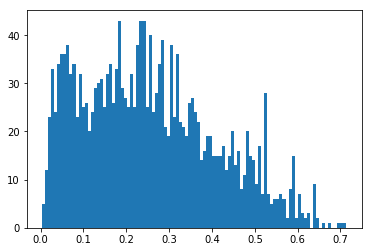
dataset.set_split('val')
batch_generator = generate_nmt_batches(dataset,
batch_size=args.batch_size,
device=args.device)
batch_dict = next(batch_generator)
model = model.eval().to(args.device)
sampler = NMTSampler(vectorizer, model)
sampler.apply_to_batch(batch_dict)
all_results = []
for i in range(args.batch_size):
all_results.append(sampler.get_ith_item(i, False))
top_results = [x for x in all_results if x['bleu-4']>0.1]
len(top_results)
54
for sample in top_results:
plt.figure()
target_len = len(sample['sampled'])
source_len = len(sample['source'])
attention_matrix = sample['attention'][:target_len, :source_len+2].transpose()#[::-1]
ax = sns.heatmap(attention_matrix, center=0.0)
ylabs = ["<BOS>"]+sample['source']+["<EOS>"]
#ylabs = sample['source']
#ylabs = ylabs[::-1]
ax.set_yticklabels(ylabs, rotation=0)
ax.set_xticklabels(sample['sampled'], rotation=90)
ax.set_xlabel("Target Sentence")
ax.set_ylabel("Source Sentence\n\n")
/home/brian/anaconda3/envs/nlpbook/lib/python3.7/site-packages/matplotlib/pyplot.py:514: RuntimeWarning: More than 20 figures have been opened. Figures created through the pyplot interface (`matplotlib.pyplot.figure`) are retained until explicitly closed and may consume too much memory. (To control this warning, see the rcParam `figure.max_open_warning`).
max_open_warning, RuntimeWarning)
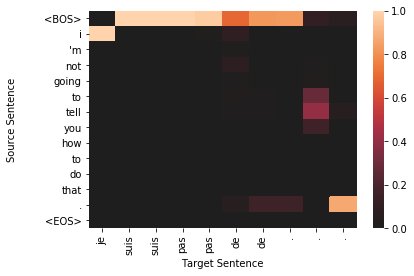
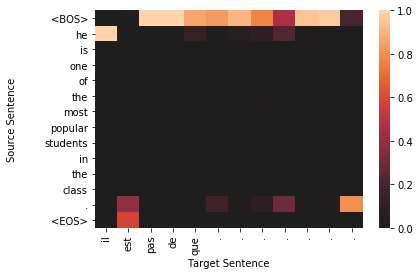
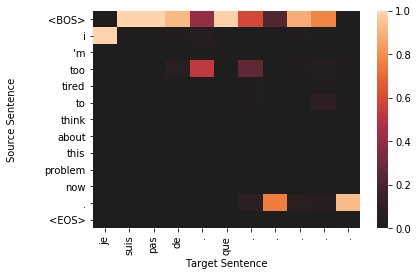
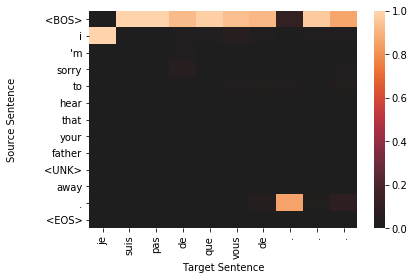
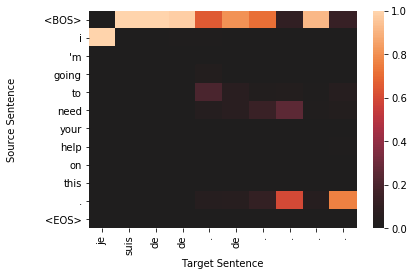
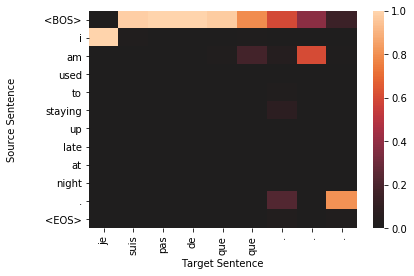
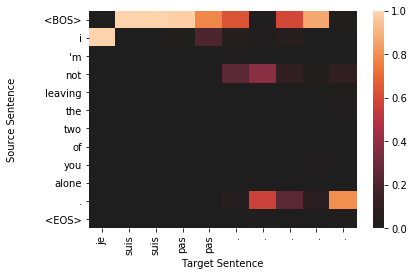
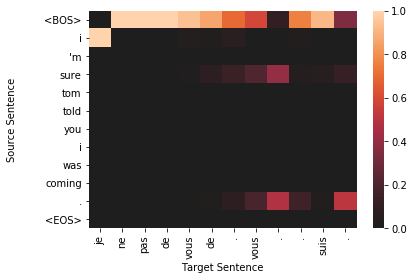
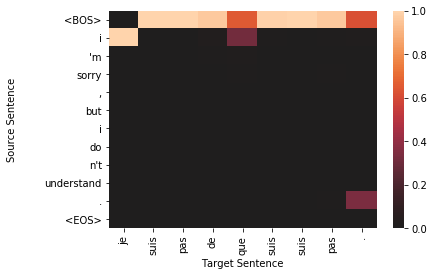
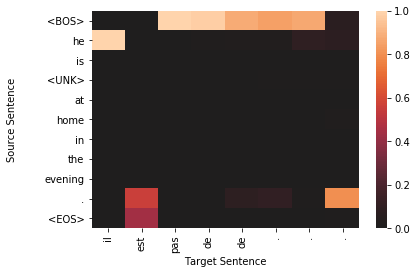
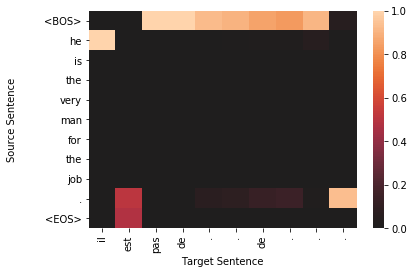
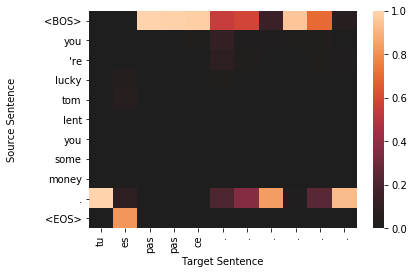
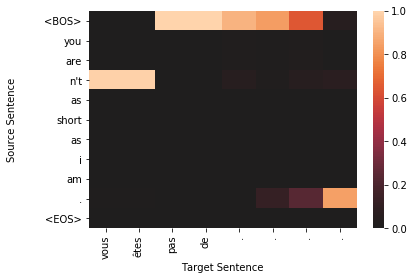
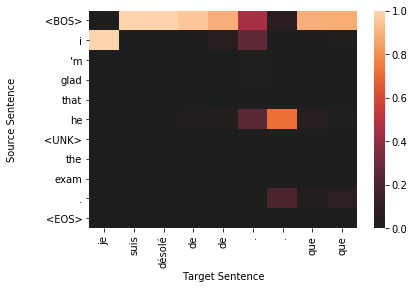
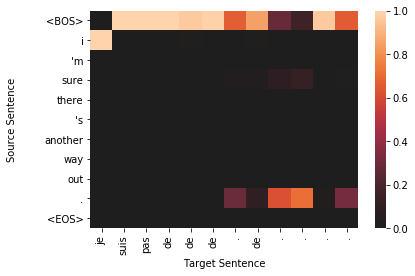
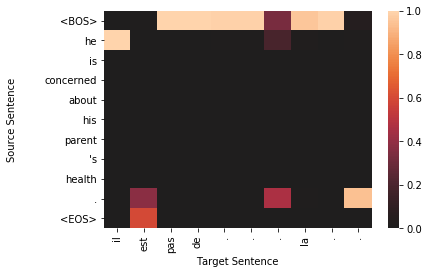
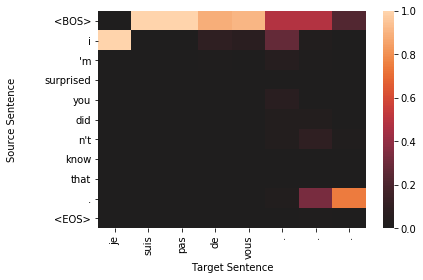
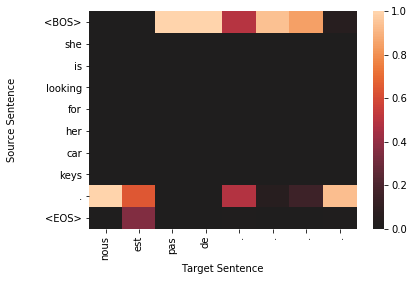
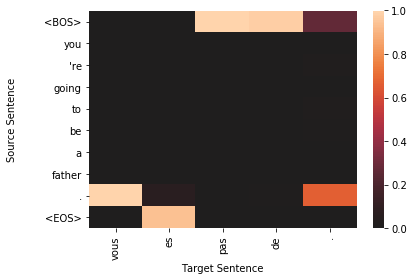
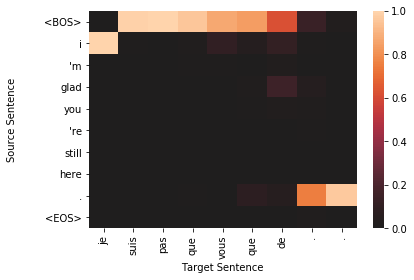
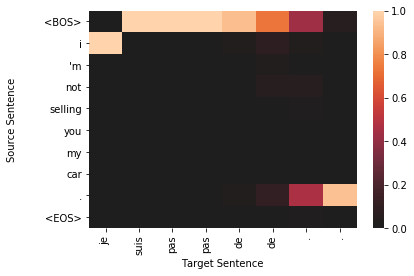
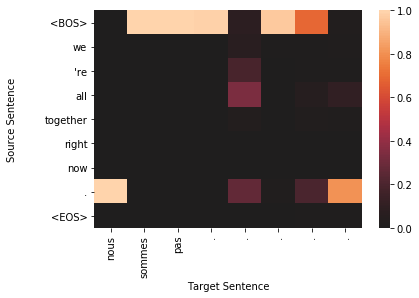
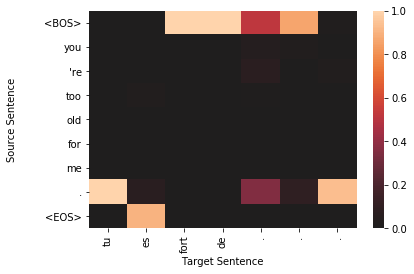
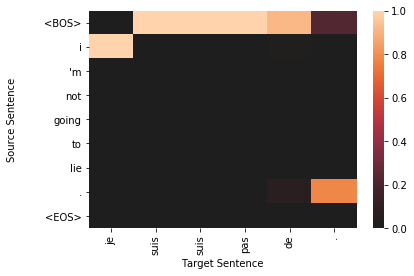
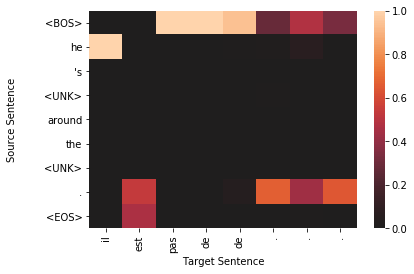
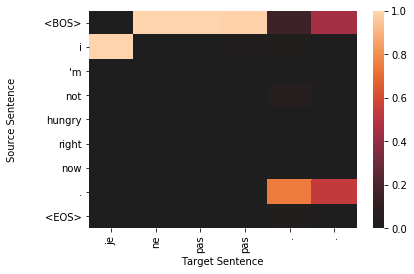
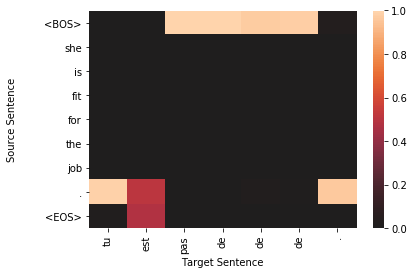
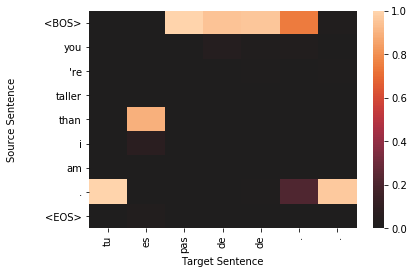
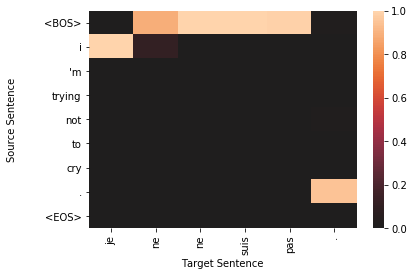
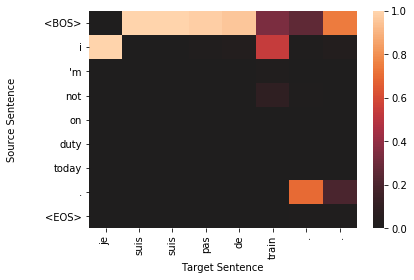
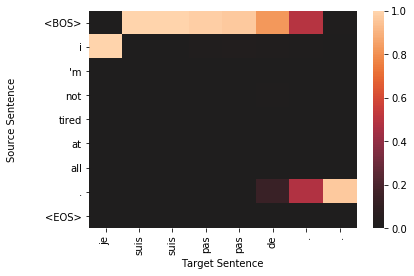
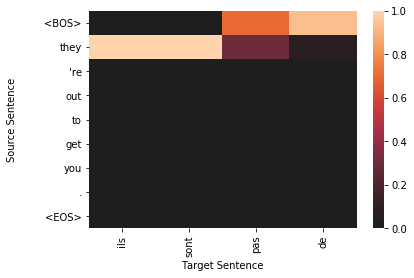
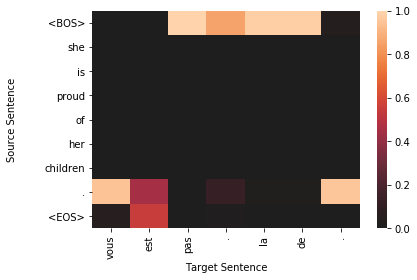
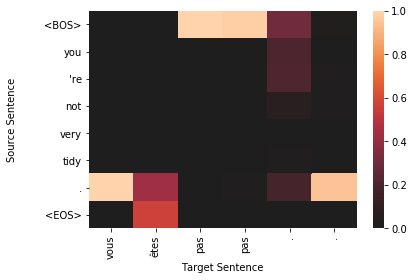
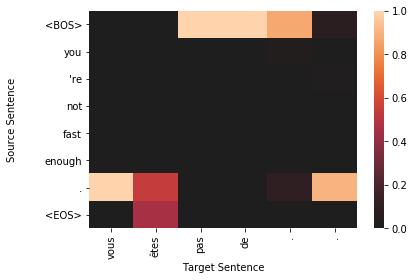
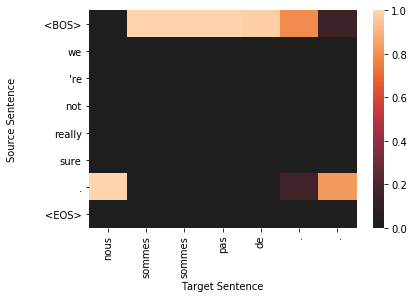
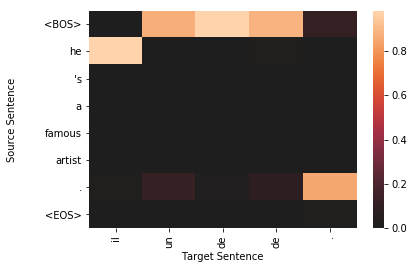
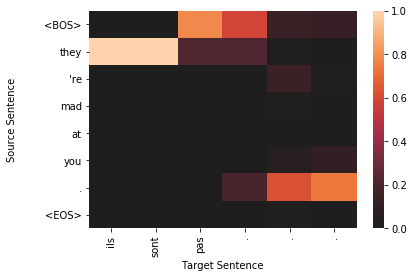
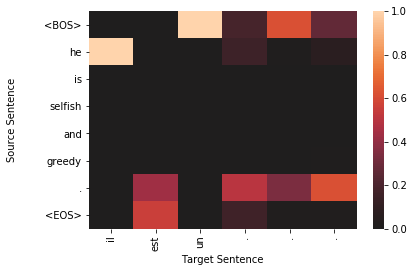
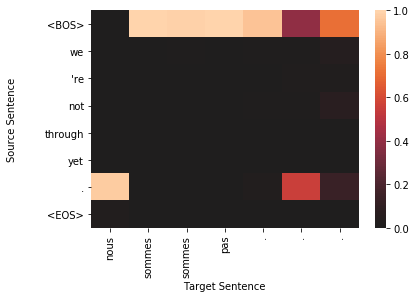
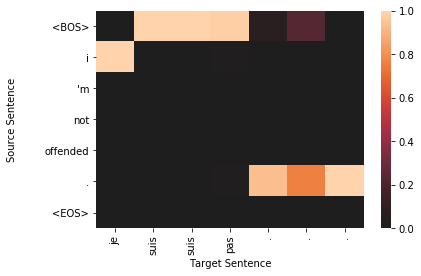
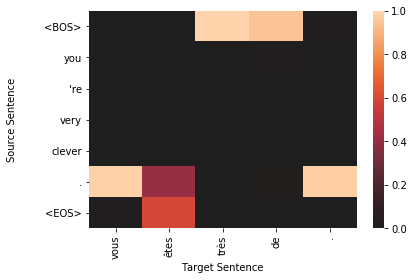
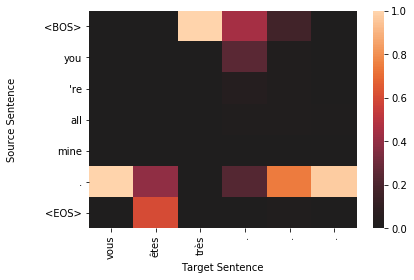
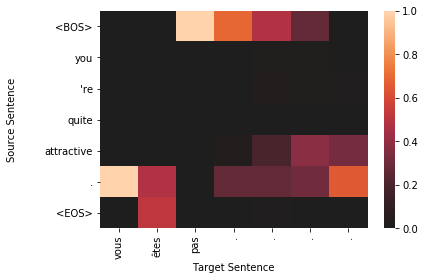
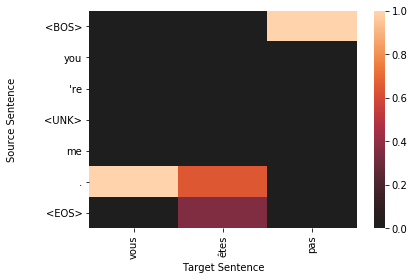
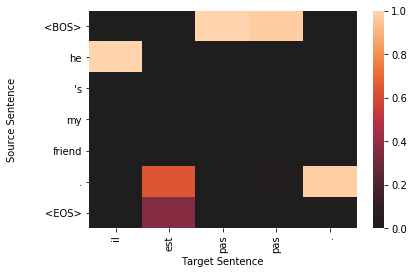
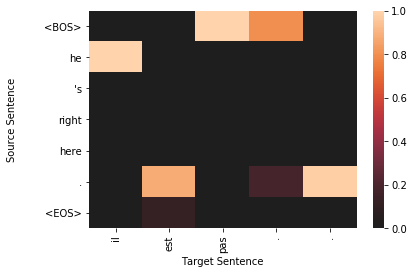
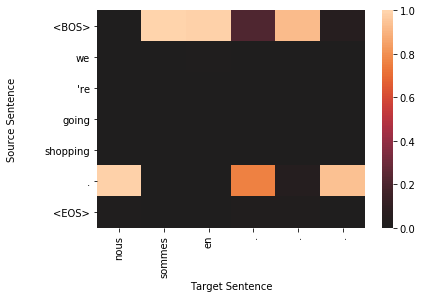
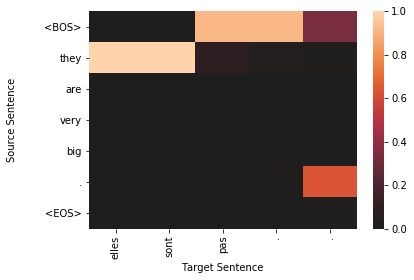
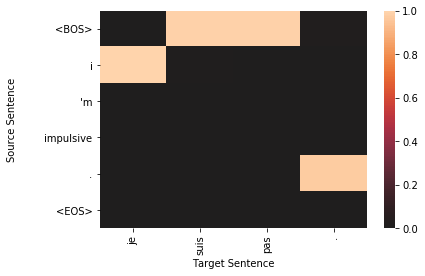
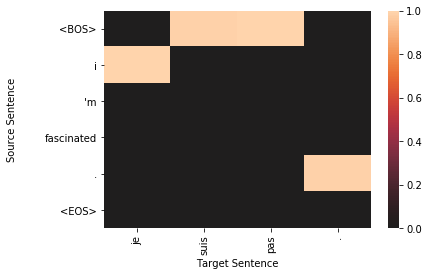
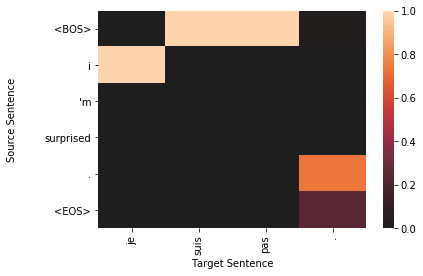
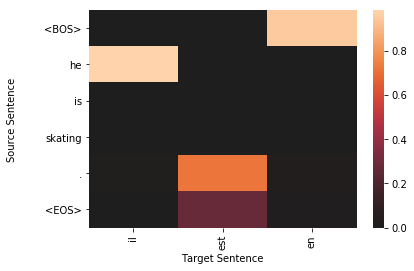
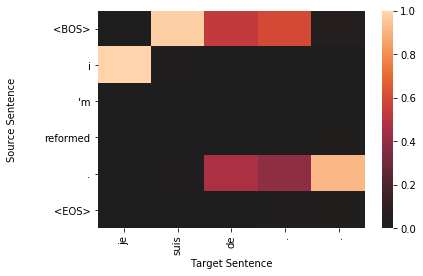
def get_source_sentence(vectorizer, batch_dict, index):
indices = batch_dict['x_source'][index].cpu().data.numpy()
vocab = vectorizer.source_vocab
return sentence_from_indices(indices, vocab)
def get_true_sentence(vectorizer, batch_dict, index):
return sentence_from_indices(batch_dict['y_target'].cpu().data.numpy()[index], vectorizer.target_vocab)
def get_sampled_sentence(vectorizer, batch_dict, index):
y_pred = model(x_source=batch_dict['x_source'],
x_source_lengths=batch_dict['x_source_length'],
target_sequence=batch_dict['x_target'])
return sentence_from_indices(torch.max(y_pred, dim=2)[1].cpu().data.numpy()[index], vectorizer.target_vocab)
def get_all_sentences(vectorizer, batch_dict, index):
return {"source": get_source_sentence(vectorizer, batch_dict, index),
"truth": get_true_sentence(vectorizer, batch_dict, index),
"sampled": get_sampled_sentence(vectorizer, batch_dict, index)}
def sentence_from_indices(indices, vocab, strict=True):
ignore_indices = set([vocab.mask_index, vocab.begin_seq_index, vocab.end_seq_index])
out = []
for index in indices:
if index == vocab.begin_seq_index and strict:
continue
elif index == vocab.end_seq_index and strict:
return " ".join(out)
else:
out.append(vocab.lookup_index(index))
return " ".join(out)
results = get_all_sentences(vectorizer, batch_dict, 1)
results
{'source': "i 'm not going to tell you how to do that .",
'truth': 'je ne vais pas te dire comment le faire .',
'sampled': 'je suis suis pas de de de . . .'}
